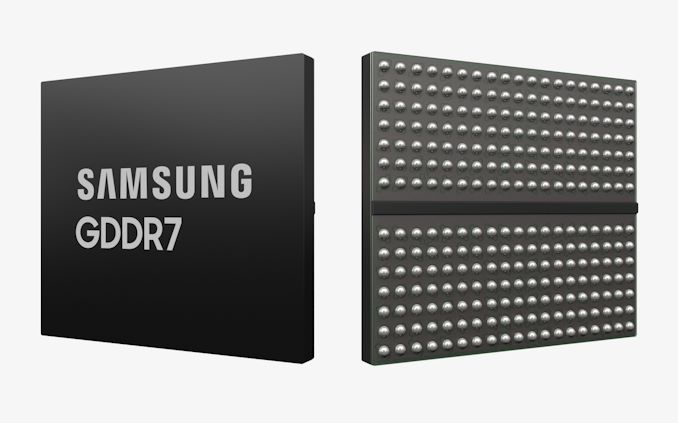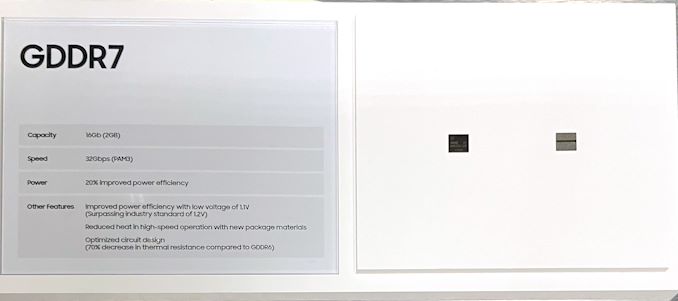GDDR7 Approaches: Samsung Lists GDDR7 Memory Chips on Its Product Catalog
by Anton Shilov on March 27, 2024 3:00 PM EST
Now that JEDEC has published specification of GDDR7 memory, memory manufacturers are beginning to announce their initial products. The first out of the gate for this generation is Samsung, which has has quietly added its GDDR7 products to its official product catalog.
For now, Samsung lists two GDDR7 devices on its website: 16 Gbit chips rated for an up to 28 GT/s data transfer rate and a faster version running at up to 32 GT/s data transfer rate (which is in line with initial parts that Samsung announced in mid-2023). The chips feature a 512M x32 organization and come in a 266-pin FBGA packaging. The chips are already sampling, so Samsung's customers – GPU vendors, AI inference vendors, network product vendors, and the like – should already have GDDR7 chips in their labs.
The GDDR7 specification promises the maximum per-chip capacity of 64 Gbit (8 GB) and data transfer rates of 48 GT/s. Meanwhile, first generation GDDR7 chips (as announced so far) will feature a rather moderate capacity of 16 Gbit (2 GB) and a data transfer rate of up to 32 GT/s.
Performance-wise, the first generation of GDDR7 should provide a significant improvement in memory bandwidth over GDDR6 and GDDR6X. However capacity/density improvements will not come until memory manufacturers move to their next generation EUV-based process nodes. As a result, the first GDDR7-based graphics cards are unlikely to sport any memory capacity improvements. Though looking a bit farther down the road, Samsung and SK Hynix have previously told Tom's Hardware that they intend to reach mass production of 24 Gbit GDDR7 chips in 2025.
Otherwise, it is noteworthy that SK Hynix also demonstrated its GDDR7 chips at NVIDIA's GTC last week. So Samsung's competition should be close behind in delivering samples, and eventually mass production memory.
Source: Samsung (via @harukaze5719)











18 Comments
View All Comments
meacupla - Wednesday, March 27, 2024 - link
GDDR6 was supposed to have up to 24Gbit (3GB) and 32Gbit (4GB) densities, but those never showed up.And it looks like GDDR7 24Gbit (3GB) density won't show up until 2025, or probably 1 to 1.5 years from now.
So don't expect any interesting dekstop GPUs to arrive before 2025 March.
Dante Verizon - Wednesday, March 27, 2024 - link
5060 9gb successfully confirmed.nandnandnand - Wednesday, March 27, 2024 - link
That would be really funny, if the 5090 launched first with 24 GB using 2 GB chips, and Nvidia waited so long to release low/mid chips that we get the 96-bit 9 GB wonder.Hrel - Tuesday, May 14, 2024 - link
If they put 96bit memory interface on a RTX XX60 class card they deserve to burn. That's absurd. At this point the XX50 class card should be able to play everything at 4K. It's a dedicated GPU for crying out loud! People should be able to game on it! That means it's gonna need AT LEAST 512GB/s of memory bandwidth and at least an 8GB frame buffer.The 40XX series was a slap in the face. I bought one cause my GPU was 10 years old, and the AMD one I got has driver issues that AMD themselves essentially said "we have no idea, we give up." Random audio issues, never the same, never consistent, totally irritating. Sound just pops in and out, crackles, volume dips and jumps for no reason. But only sometimes, unless you forgot about it, then it's just happening every 30 seconds. Everyone at AMD, MSI and myself included gave up. They said it was fixed in the 7XXX series, issue just exists on 6650XT when you use an audio receiver between your PC and TV. I don't believe them it's fixed on the 7 series, if it was they'd be able to define what was going on. I digress.
meacupla - Thursday, March 28, 2024 - link
I wouldn't be surprised to see that.At the very least, I expect the 5050Ti mobile or 5060 mobile to have that configuration.
Kevin G - Thursday, March 28, 2024 - link
This is how we'll likely get 12 GB capacity cards using a 128 bit wide bus in 2025 for the low end.The new midrange will likely be a mix of 12 GB and 18 GB cards via a 192 bit wide bus.
The 256 bit wide GPUs will likely stick to just 16 GB and 384 bit wide units will continue with 24 GB for consumers. The workstation variants of these cards though will use the higher capacity dies for 24 GB and 36 GB respectively. Absolute high end will leverage memory on both sides of the board to jump to a 72 GB capacity.
Hrel - Tuesday, May 14, 2024 - link
I hope you're right, those are reasonable numbers. The 4XXX series was a slap in the face. 8GB vram on a 128bit but on the RTX4060TI?! Seriously?! I mean if they were charging $200 that'd be fine but they aren't, $400!!!!!!RTX 5050 better have AT LEAST 128bit at 12GB.
NextGen_Gamer - Wednesday, March 27, 2024 - link
Just because the initial density of GDDR7 is the same doesn't mean there won't be an interesting GPU launches. 16GB and above is still perfectly fine for high-end GPUs. And rumors point to the big boy "Blackwell" from NVIDIA as moving to a 512-bit bus, which would mean 32GB VRAM using these announced GDDR7 chips from Samsung. AMD could possibly do the same, and in fact would have an easier time due to their chiplet design.meacupla - Wednesday, March 27, 2024 - link
It's not going to be interesting when the RTX 5090 costs around $2000 - $2500.The next step down, the GB203 die only has a 256-bit mem bus and 16GB for a 5080 sounds boring.
16GB on a 5070 wouldn't be bad, except those get the GB204 die with a 192-bit mem bus. 12GB for a 70 class? yeah, no thanks.
Threska - Thursday, March 28, 2024 - link
Ah well $2k should buy some nice power cables to keep the "interest" to a minimum.